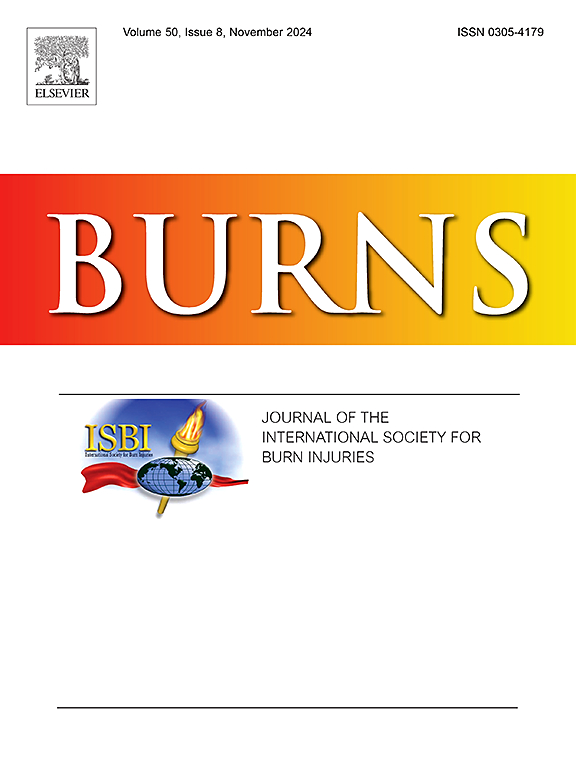厨房烹饪烧伤:加纳成人和儿童的真正危险
IF 3.2
3区 医学
Q2 CRITICAL CARE MEDICINE
引用次数: 0
摘要
在许多低收入和中等收入国家(LMICs),炉子和燃料堆放是常见的做法。然而,堆积对健康的影响,特别是烹饪相关烧伤(CRBs),尚不清楚。本研究旨在调查crb的患病率和严重程度,并确定相关的家庭因素。重点放在影响crb的烹饪行为和做法(即燃料选择和堆叠)上。方法本研究是“煤型燃料用于烹饪燃料项目”(B4CcokingF)的基础,该项目是在加纳南部河岸社区进行的一项随机对照试验。基线数据收集于2019年6月开始,于2022年10月结束。首先,训练有素的现场工作人员在一名社区代表的带领下,访问了每个社区的符合条件的家庭(HHs),并使用结构化问卷进行了访谈。为监测家庭能源使用情况和可持续发展目标(SDG)指标7.1.1和7.1.2,对年龄在25岁至68岁之间的420名初级厨师进行了访谈,内容涉及烹饪行为和做法以及与烹饪有关的烧伤和伤害,访谈采用了一份经过略微修改、完善和验证的世界卫生组织(世卫组织)统一调查问卷。结果成人初级厨师中scbs患病率为31.8% %。大多数中度和重度慢性粒细胞白血病(分别约为61% %和27% %)发生在厨房,与热炉子接触。属于中等财富指数的状态对成人crb有保护作用,但在HH中有超过10人是成人crb的重要危险因素。HH的房间数量每增加一个单位,成人发生crb的风险就增加43% %。大约16% %的儿童遭受crb, 64% %的儿童遭受严重烧伤,这些事故大多发生在家里的厨房。家庭规模为6-10人的HH与crb呈正相关,但使用LPG炉灶对儿童有保护作用。混合堆叠定义为将LPG与污染燃料堆叠(PR=2.10, 95 %,置信区间(CI): 1.12, 3.94)与儿童的crb相关,但与成人无关。结论成人crb的影响因素包括中等财富指数状况、家庭房间数、10人以上。家庭规模在6-10人之间以及HH使用液化石油气与儿童CRB风险相关。混合堆叠与儿童的crb有关,但对成人厨师的研究结果尚无定论。儿童人口受到的影响尤为严重;因此,开发和执行针对其特定漏洞的定制的预防性计划是必要的。加纳加强获得液化石油气的主动行动的首要目标应该是确保安全使用。本文章由计算机程序翻译,如有差异,请以英文原文为准。
Kitchen cooking burns: A real danger for adults and children in Ghana
Background
In many low- and middle-income countries (LMICs), stove and fuel stacking are frequent practices. However, the impact of stacking on health, particularly cooking-related burns (CRBs), is unknown. This study aims to examine the prevalence and severity of CRBs and to identify associated household factors. Emphasis was placed on cooking behaviors and practices (i.e., fuel choice and stacking) that influence CRBs.
Methods
This study is a baseline for the Briquette for Cooking Fuel Project (B4CcokingF), a cluster randomized controlled trial in riparian communities in southern Ghana. The baseline data collection started in June 2019 and ended in October 2022. To start with, trained field workers, led by a community representative, visited eligible households (HHs) in each community and conducted interviews with a structured questionnaire. 420 primary cooks age between 25 and 68 years were interviewed on cooking behaviour and practices as well as cooking-related burns and injuries using a slightly modified, well-established, and validated World Health Organization (WHO)-harmonized questionnaire to monitor household energy use and Sustainable Development Goals (SDG) indicators 7.1.1 and 7.1.2.
Results
CRBs were prevalent in 31.8 % of adult primary cooks. The majority of moderate and severe CRBs—roughly 61 % and 27 %, respectively—occurred in the kitchen by contact with a hot stove. Belonging to a middle wealth index status was protective against CRBs in adults but having more than 10 people in a HH was a significant risk factor of adult CRBs. A unit increase in the number of rooms in a HH was associated with a 43 % increase in the risk of CRBs in adults. Approximately 16 % of children suffer from CRBs, and 64 % sustain severe burns, with the majority of these incidents occurring in the kitchen at home. A HH having a family size of 6–10 was positively associated with CRBs, but using an LPG cookstove was protective in children. Mixed stacking defined as stacking LPG with polluting fuel (PR=2.10, 95 %, confidence interval (CI): 1.12, 3.94) was associated with CRBs in children but not adults.
Conclusion
Factors associated with adult CRBs include middle wealth index status, the number of rooms in a household, and having more than 10 people in a household. Having a family size of 6–10 and the use of LPG by the HH were associated with child CRB risk. Mixed stacking is associated with CRBs in children, but the findings among adult cooks were inconclusive. The children population is disproportionately affected; therefore, it is essential to develop and execute customized preventative initiatives that cater to their specific vulnerabilities. The paramount objective of Ghana's initiatives to enhance access to liquefied petroleum gas should be the assurance of safe usage.
求助全文
通过发布文献求助,成功后即可免费获取论文全文。
去求助
来源期刊

Burns
医学-皮肤病学
CiteScore
4.50
自引率
18.50%
发文量
304
审稿时长
72 days
期刊介绍:
Burns aims to foster the exchange of information among all engaged in preventing and treating the effects of burns. The journal focuses on clinical, scientific and social aspects of these injuries and covers the prevention of the injury, the epidemiology of such injuries and all aspects of treatment including development of new techniques and technologies and verification of existing ones. Regular features include clinical and scientific papers, state of the art reviews and descriptions of burn-care in practice.
Topics covered by Burns include: the effects of smoke on man and animals, their tissues and cells; the responses to and treatment of patients and animals with chemical injuries to the skin; the biological and clinical effects of cold injuries; surgical techniques which are, or may be relevant to the treatment of burned patients during the acute or reconstructive phase following injury; well controlled laboratory studies of the effectiveness of anti-microbial agents on infection and new materials on scarring and healing; inflammatory responses to injury, effectiveness of related agents and other compounds used to modify the physiological and cellular responses to the injury; experimental studies of burns and the outcome of burn wound healing; regenerative medicine concerning the skin.
 求助内容:
求助内容: 应助结果提醒方式:
应助结果提醒方式:


